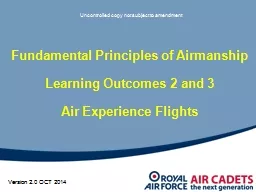

Learning Outcomes 2 and 3 Air Experience Flights Uncontrolled copy not subject to amendment Version 20 OCT 2014 Objectives Understand the types of AEF in the ACO Introduce the ACO Basic Trainer The ID: 785086
Download The PPT/PDF document "Fundamental Principles of Airmanship" is the property of its rightful owner. Permission is granted to download and print the materials on this web site for personal, non-commercial use only, and to display it on your personal computer provided you do not modify the materials and that you retain all copyright notices contained in the materials. By downloading content from our website, you accept the terms of this agreement.
Slide1
Fundamental Principles of AirmanshipLearning Outcomes 2 and 3Air Experience Flights
Uncontrolled copy not subject to amendment
Version 2.0 OCT 2014
Slide2ObjectivesUnderstand the types of AEF in the ACOIntroduce the ACO Basic Trainer – The Grob Tutor
Have a basic understanding of Flight ControlsUnderstand safety in the airUnderstand safety on the ground
Review the Tutor Passenger Brief Video
Slide3Flying with the ACOAir Experience flights – Grob Tutor 115Operational Aircraft on an opportunity basis
Civil Flights on an opportunity basisCadets must be 13 years 3 monthsHave completed Cadet Basic Training, had a safety brief or be First Class cadet
Slide4Opportunity Flights in Operational Aircraft
CH-47 Chinook
Slide5Tristar
Opportunity Flights in
Operational Aircraft
Slide6C-130 Hercules
Opportunity Flights in Operational Aircraft
Slide7Your Local Air Experience Flight
Click on the map to view AEF Locations in Google Earth
Slide81 Air Experience FlightRAF St Athan Return to Map
Next Slide
Slide92 Air Experience FlightBoscombe Down
Return to Map
Next Slide
Slide103 Air Experience FlightRAF Colerne
Return to Map
Next Slide
Slide114 Air Experience FlightGlasgow Airport
Return to Map
Next Slide
Slide125 Air Experience FlightRAF Wyton
Return to Map
Next Slide
Slide136 Air Experience FlightRAF Benson
Return to Map
Next Slide
Slide147 Air Experience FlightRAF Cranwell
Return to Map
Next Slide
Slide158 Air Experience FlightRAF Cosford
Return to Map
Next Slide
Slide169 Air Experience FlightRAF Church Fenton
Return to Map
Next Slide
Slide1710 Air Experience FlightRAF Woodvale
Return to Map
Next Slide
Slide1811 Air Experience FlightRAF Leeming
Return to Map
Next Slide
Slide1912 Air Experience FlightRAF Leuchars Return to Map
Next Slide
Slide20Grob Tutor 115
Slide21Grob
Tutor 115
Slide22Grob Tutor 115
Slide23Grob Tutor 115
Slide24Grob Tutor 115
Slide25Wingspan: 10.0mLength: 7.6mHeight: 2.8mMax Weight: 990KgEngine: 180hp
Max Speed: 185 knots
Side-by-side 2 seat tandem
Carbon Fibre construction
Grob
Tutor 115
Slide26Cockpit Layout
Slide27Flight Instruments - Altimeter
Slide28Attitude Indicator (or Artificial Horizon)
Slide29Airspeed Indicator
Slide30Vertical Speed Indicator
Slide31Flight Controls
Slide32Control Surfaces
Aileron
Elevator
Rudder
Slide33Control Surfaces – what do they look like in real life?
Elevator
Aileron
Rudder
Slide34Elevator
Aileron
Rudder
Control Surfaces – what do they look like in real life?
Slide35The axes of an Aircraft
Slide36Longitudinal Axis – “roll”
Controlled by Ailerons
Slide37Vertical Axis – “yaw”
Controlled by
the Rudder
Slide38Lateral Axis – “pitch”
Controlled by Elevators
Slide39Ailerons
Slide40Control
column
Push right
Slide41Left aileron down
Right aileron up
Slide42Aircraft rolls right
Slide43Aircraft rolls right
Slide44And continues to do so until thecontrol column is placedin the neutral position
Aircraft rolls right
Slide45Control column leftLeft aileron upRight aileron downAircraft rolls left
Summary
Slide46Rudder
Slide47The rudder is controlled by
‘Rudder Pedals’ in the cockpit
Slide48Rudder pedals set to neutral
Slide49Push right pedal forwards (left will come back towards you!)
Rudder moves
right
Slide50Aircraft yaws
right
Slide51Aircraft yaws
right
Slide52Aircraft yaws
right
Slide53Push right pedal forwardRudder moves rightAircraft moves rightPush left pedal forwardRudder moves left
Aircraft moves left
Summary
Slide54Elevator
Slide55Control
column
Push
Forward
Slide56Elevator
moves
down
Slide57Nose
pitches down
Slide58Nose
pitches down
Slide59Nosepitches down
And continues to do so until the
control column is placed
in a neutral position
Airspeed will
increase
Slide60Control column backElevator moves upNose pitches upSpeed will decrease
Summary
Slide61Air Experience Flight Safety Briefing Video
Slide62Safety on the ground
Slide63When on the GroundNever approach an aircraft unless told to do soNever walk towards the propeller.
Always approach from an angle that can be seenRemove any hats in the aircraft dispersal area
Look and Listen
Slide64Slide65Parachute Fitted
Slide66Seat Harness
Slide67Rip Chord Extended
Only pull this chord in an emergency bale out!
And when you have fallen clear of the aircraft
Slide68When on the GroundIf near a Jet beware of both the intake and the exhaust areasKeep hands away from your parachute ’D’ ring
Listen to the Ground Crew or Staff Cadets
Slide69Ready to go!
Slide70Safety in the air
Slide71While in the Air Talk to the pilot – ask questionsAsk to see the effects of the controls
Ask about the instrumentsOnly touch the controls when told to do so by the pilot who will say “follow through” or “you have control”
Slide72While in the Air Keep hands and feet away from the controls if you are not flying the aircraftListen to any commands, if not sure ask to repeat
Ensure that you have no loose articles in your pocket
Slide73SummaryAsk QuestionsAsk to take controlDo not touch unless told to do so
Think SafeLook and Listen
Slide74Above all else...... Enjoy your flight
Slide75ObjectivesUnderstand the types of AEF in the ACOIntroduce the ACO Basic Trainer –The TutorHave a basic understanding of Flight ControlsUnderstand safety in the air
Understand safety on the groundReview the Tutor Passenger Brief Video
Slide76Any Questions?
Slide77QuestionsWhat does AEF stand for?Name the aircraft we use for AEF?What is the number of your local AEF?What happens when you move the control column to the right?
From which direction should you approach the Tutor?
Slide78QuestionsWhich control can you touch first?What is an ASI?What is an Artificial Horizon?What is this?